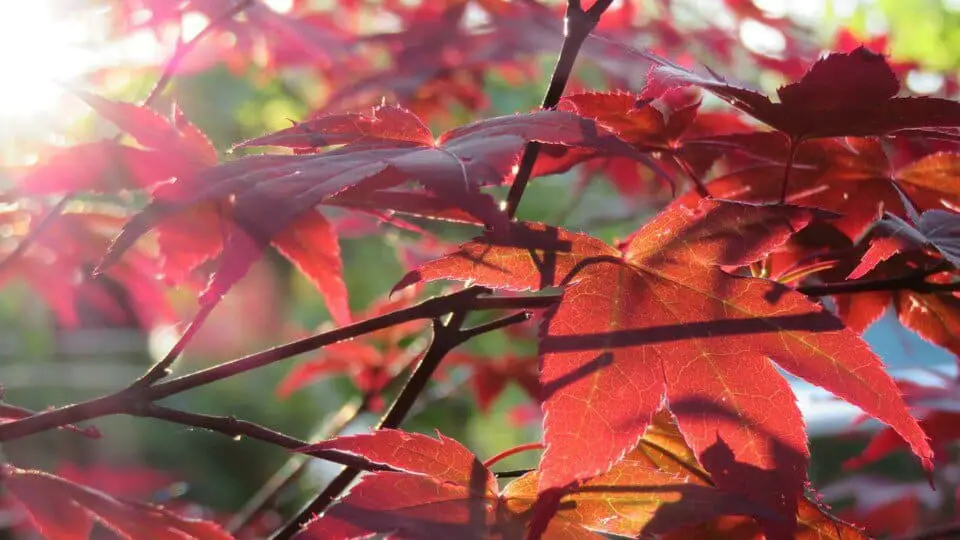Some links in the post are affiliate links and I get a commission from purchases made through some links found in the post.
Like other maple trees, the Japanese maple is a wondrous species that changes its hue as the seasons change. Its leaves take on a green or red hue in the active growing season.
The tree can even have both green and red leaves in some cases. And in the fall, you get to watch the leaves turn red, orange, purple, or yellow hues.
To add to their allure, Japanese maple leaves come in different textures. Some feature broad lobes, while others have dissections. It doesn’t take much to understand why anyone would want to have these trees in their garden.
Besides their beautiful leaves, Japanese maples also enhance your garden’s beauty with their flowers.
These trees bloom in the spring, producing small flowers which can be red or purple. Eventually, these flowers develop into samaras which are dry winged fruits that measure about half an inch.
You might think that because these are flowering species, you need to place them in the full sun. But that would be a mistake with the Japanese maple, a species whose botanical name is Acer Palmatum.
The Japanese maple, native to Japan, Korea, China, and some parts of Russia and Mongolia, prefers being in full sun or partial shade. The Japanese maple likes at least 4 to 6 hours of light per day.
In the early years of the tree you may see scorching of the leaves if the tree is planted in full sun.
Placing it in the full sun would only stress it and delay its growth. This guide details the light exposure to give your Japanese maple and what happens when you fall short of the standard.
What Type of Light Does My Japanese Maple Need?
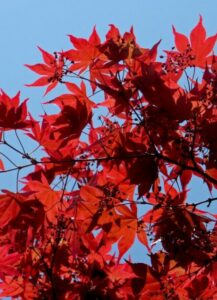 If you don’t understand how a plant utilizes light, you may have difficulty understanding why your plant needs a certain amount of light exposure.
If you don’t understand how a plant utilizes light, you may have difficulty understanding why your plant needs a certain amount of light exposure.
So, let’s start there. Your plant relies on photosynthesis to make the food which gives it the energy to develop more cells, grow wider and taller, and strengthen its immune system.
Photosynthesis comes down to converting water, light, and nutrients to create this food. The photo in the name implies the presence of light.
When a plant gets enough light to trigger photosynthesis, it grows as it should and is less susceptible to pests and diseases. But when it grows in a deficit, its plant processes suffer a hit, and that’s when trouble begins.
Plants don’t need the same light exposure. Some can do well with limited light, especially those suited for growing in lower USDA zones – while others must have the highest light exposure to trigger enough photosynthesis for healthy growth.
That’s why you come across terms such as:
1) Full Sun
This light exposure implies at least six hours of direct sunlight exposure. It also goes by the term bright and direct light, signifying the lack of a barrier between the sun’s rays and the plant.
Most flowering plants prefer this kind of exposure to make enough food to support foliage growth and flower development.
2) Partial Sun
This exposure, also known as bright and indirect light, requires that the plant gets at least 4 hours of sun exposure.
You can do this by exposing it to the morning or afternoon sun. For the other hours, the plant does not get direct light.
3) Partial Shade
This exposure is like partial sun with at least 4 hours of sun exposure a day. However, in this case, the emphasis lies in shading the plant from harsh sun rays.
As such, a plant that needs such exposure should only receive morning sun and not the afternoon sun.
4) Filtered or Dappled Light
This light also falls under bright and indirect light But in this case, the plant receives light filtered by a taller species. For example, placing your Japanese maple under a taller tree would avail such light.
5) Full Shade
You might think that the equivalent of full shade would be no sun, but that could not be further from the truth.
Instead, it refers to exposure to about 4 hours of morning or afternoon sun. It also applies to plants that receive a whole day of dappled or filtered light.
So, what kind of exposure does the Japanese maple need? You would think that it would require full sun to promote the development of healthy flowers in the spring.
But that is not the case. Instead, it prefers being in partial shade or filtered sun.
You may also like: Japanese maple vs red maple
How Much Light Does a Japanese Maple Need?
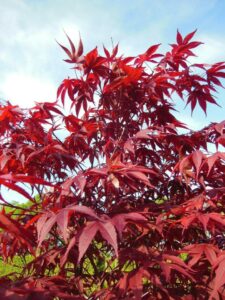 The Japanese maple does well in USDA zones 5 to 9, which have relatively cool climates. Your tree should get:
The Japanese maple does well in USDA zones 5 to 9, which have relatively cool climates. Your tree should get:
- At least 4 to 6 hours of partial shade,
- At least 4 hours of dappled light, or
- An equivalent of the two above.
It does not need full sun to develop healthy foliage and flowers. And it will not do well in full shade. The key is to balance the extreme light exposures, and the tree will grow well.
What Happens If Your Japanese Maple Gets Too Little Light?
The good thing is that Japanese maples do not rely on full sun exposure to grow. After all, they grow in the shade of other trees in the wild.
And this makes them relatively tolerant to partial shade. But growing them in the full shade often results in issues such as:
1) Sparse Growth
Usually, the crown of Japanese maples is quite dense and features many leaves. But when the plant does not have access to enough light, its growth suffers. As such, the crown may not be as dense.
2) Pale Leaves
Japanese maples come in different cultivars, and some of these species feature red leaves. When these do not get enough light, the hue on their leaves diminishes, and they appear duller than usual.
3) Leaning Stem
Your Japanese maple may try to grow towards the light, resulting in a bend in its stem. Its branches will also likely follow suit, thus affecting its aesthetic appearance.
4) Wet Soil
Do you know how soil dries? The common notion is that the heat from the sun dries out the soil. But that is just a part of it.
Your tree also absorbs water from the soil to aid in photosynthesis. And when it does not have enough access to light, its water absorption rate reduces.
You find that the tree sits in the water longer than it should, putting it at risk of root rot.
These problems are more likely to arise in the cooler regions where the light intensity is low. As such, shading the plants robs them of the chance to photosynthesize enough to support healthy growth and blooming.
What Happens If Your Japanese Maple Gets Too Much Light?
Placing your Japanese maple in the full sun, especially in hot climates, can result in the following issues:
Brown Spots on the Leaves
In higher USDA zones, the sun’s intensity may be too much for the tree to handle. And the rays can damage the leaves, burning them and stopping photosynthesis in its tracks.
Such damage is irreversible and puts the plant at risk of pest infestations. You should note that brown spots on the leaves can sometimes result from other issues.
Thus, it is best to rule out these other possibilities before relocating your plant if the damage is severe.
You may also like: Why is your Japanese Maple Turning Green
Wilting
If the plant appears droopy, this implies that the absorption rates are lower than the transpiration and evaporation rates. Over time, this can stress the plant and hamper its growth.
To deal with these issues, you can try mulching the tree’s base and watering it when the soil feels dry. If these tactics do not bear fruit, you can consider shading the tree or moving it to another location.
Can Japanese Maples Grow in Shade?
The term shade can refer to partial or full shade.
- Partial shade is the equivalent of partial sun, where the plant gets at least four hours of sunlight exposure per day. However, the focus lies on morning sunshine as it is gentle and just what the plant needs to make food.
- Full shade has less light exposure equating to up to 4 hours of sun exposure, which can be in the morning or afternoon.
Japanese maples do well in partial shade but do not grow well in full shade.
You may also like: 6 reasons your acer tree is dying & how to fix it
Can Japanese Maples Be in Full Sun?
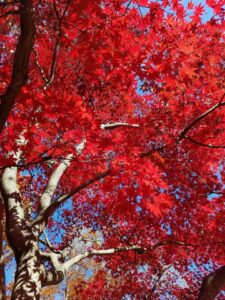 The Japanese maple has many cultivars, and they all have different growing requirements. However, none of them can tolerate the afternoon sun as it tends to be too harsh.
The Japanese maple has many cultivars, and they all have different growing requirements. However, none of them can tolerate the afternoon sun as it tends to be too harsh.
If you place your tree in full sun conditions or partial sun that leans on the afternoon sun, you will encounter some of the issues we covered under too much light.
Most notably, the plant will suffer sunburn, damaging its leaves and reducing its ability to make food.
Moreover, the plant would spend its energy healing the damaged parts, and subsequent activities like flowering would take a backseat.
It is best to avoid full or partial sun as much as you would steer clear of full shade.
Where To Place Your Japanese Maple to Get The Best Light
The key things to consider when positioning a Japanese maple are:
- How many hours of exposure it should get: Ideally, the tree should get at least 4 hours of light,
- What kind of light it should get: The tree does not like full sun, full shade, or the afternoon sun.
You should avoid placing the plant towards the south of your garden if you live in the northern hemisphere. And keep off the north of the garden if you live in the south.
These spots receive full sun, which would stress the tree. Also, avoid the west of the garden as this would receive bright and direct sunlight in the afternoon.
These rays are harsher than what the plant gets in the morning and can damage its leaves.
Where should you place your Japanese maple?
- Towards the east of the garden: Eastern sites are ideal for partial shade. They receive bright and direct light in the morning and remain shielded from the afternoon sun, giving your maple just what it needs.
- Under a taller tree: Japanese maples also do well in filtered/ dappled light as this exposure mimics what they get in their natural habitat. So, you can plant them near taller species.
Should you place your tree in the north? You should avoid placing your plant in the north of the garden if you live in the southern hemisphere.
And stay away from the south of the garden if you live in the northern hemisphere. These spots do not receive as much light as the eastern spots, and this exposure could result in stunted growth.
For more on this, check out our article on where should you plant a Japanese maple tree.
Can Japanese Maples Grow in Artificial Light?
Some people shy away from growing Japanese maples because they do not live in the recommended USDA zones. But did you know that you can grow Japanese maples indoors?
All it takes is figuring out the kind of environment the plant needs. And when doing this, you will need to pay attention to how much light it gets.
Your Japanese maple needs light to grow. This light can come from anywhere, including the sun and your bulbs!
After all, what they need are the photons from the light that impart energy into the objects they hit. And lights have the red and blue wavelengths required to trigger the chemical reactions that constitute photosynthesis.
How To Grow a Japanese Maple Using an Artificial Light
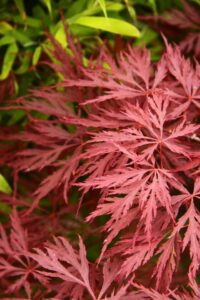 You need to note that sunlight is way more effective than artificial light owing to its intensity. It boasts more photons and thus has a better impact on photosynthesis.
You need to note that sunlight is way more effective than artificial light owing to its intensity. It boasts more photons and thus has a better impact on photosynthesis.
So, when using artificial lights, you will need to replicate something similar to what the Japanese maple would enjoy in the wild. How do you do this?
- If you’re using fluorescent lights, keep them on for 16 hours a day, and ensure they are close to the tree top with a range of at least 8 inches. Placing them too near the tree can burn its leaves.
- If using HID lights, ensure the distance between the tree and the light is at least 20 inches to account for the high energy output from the lights. Keep them on for about 10 hours a day and open the windows to allow air circulation to prevent the temperatures from getting out of hand.
- LEDs are the best artificial lights as they have the least energy output. These should be at least 10 inches from your plant and on for about 10 hours a day.
Please note that the wattage on the non-LED lights will affect the spacing between the plant and the lights. And for all the lights, you will need to pay attention to the lumens to avoid burning the plant.
You may also like: 6 benefits of a owning a Japanese maple
Final Thoughts
If your Japanese maple gets the light, water, and nutrients it needs, it can grow as tall as 25 feet (7.5 meters) with a spread that is just as expansive.
All you need is to find a spot in your garden that receives filtered sun or partial shade and avoid the full sun as much as you can. Then you can await a full bloom in the spring that adds to the beauty of your tree.
Happy Gardening!

